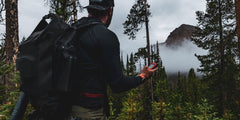
Slow & Steady: The Key to Winter and Wet Weather Driving
Most accidents happen when a driver makes a sudden change in speed or direction, and the vehicle’s traction can’t keep up. No matter what you drive, winter weather and heavy rain reduce effectiveness, so adjust accordingly.
- Slow down. Drive at a controlled pace and give yourself plenty of space between other cars.
- Stay smooth. Avoid jerky movements—steering, braking, and accelerating should be gradual.
- Test traction before getting on main roads. A quick brake tap or acceleration in a safe area can give you an idea of road conditions.
When stopping on slick pavement, try lightly tapping your brakes repeatedly rather than pressing hard all at once. This helps prevent skidding and gives your tires a better chance of maintaining traction.
Why Is My Tire Pressure Low in Cold Weather?
Cold air causes tire pressure to drop—roughly 1-2 PSI for every 10°F decrease. Lower PSI means reduced traction, poor handling, and increased tire wear.
What to Do:
- Check tire pressure regularly, ideally when tires are cold.
- Inflate tires to the manufacturer’s recommended PSI (found on your driver’s side door or in your owner’s manual).
- Keep a Zeus Air Portable Compressor in your car—it allows you to adjust tire pressure on the go for optimal performance and safety.

Improving Traction: Tires, Weight, and Clearance
Three key factors determine how well your vehicle handles in winter conditions: tires, weight distribution, and clearance.
Tires: The Foundation of Winter Grip
Your traction is only as good as your tires. Here’s what you need to know:
- All-Season Tires: Acceptable but only if they have the Three-Peak Mountain Snowflake (3PMSF) symbol on the sidewall, meaning they meet certain winter performance standard.
- Winter Tires: Best option for cold climates. Their specialized rubber compound and deep tread improve braking, acceleration, and cornering in snow and ice.

![]() Weight Distribution: More Downward Pressure = More Grip
Weight Distribution: More Downward Pressure = More Grip
Adding weight to the rear of a rear-wheel-drive vehicle can improve traction. Sandbags in the trunk can help, but don’t overload—too much weight can reduce your ability to accelerate efficiently.
Clearance: Why It Matters
If you’re driving in deep snow or off-road conditions, ground clearance becomes a factor. Vehicles with higher clearance avoid getting bogged down by plowed snow or slush buildup under the chassis.
How to Safely Navigate Wet Roads at Night
Rain-slicked roads can be tricky when they reflect headlights, making it hard to see obstacles and lane markings. Here’s how to drive safer in wet conditions:
- Watch for "Black Ice" Effects: Water mixed with road oils can create a slick surface that looks like regular pavement.
- Use Low Beams: High beams reflect off wet roads and can reduce visibility.
- Increase Following Distance: Wet roads mean longer stopping distances, so give yourself extra space.
- Slow Down & Avoid Puddles: Hydroplaning happens when your tires lose contact with the road due to excess water. Avoid standing water and drive at a steady speed.

AWD vs. 4WD: Which Is Better for Winter Driving?
There’s often confusion between All-Wheel Drive (AWD) and Four-Wheel Drive (4WD). Each has its place:
- AWD is great for mixed conditions—pavement with occasional snow or ice patches. It automatically adjusts power to different wheels based on traction needs.
- 4WD is better for deep snow, mud, and off-road conditions. It requires manual engagement and isn’t ideal for plowed roads or highways.
Most modern 4WD vehicles have multiple modes—understanding your system ensures you’re using the right setting for the conditions.
Pro Tip: Engage 4WD before you get stuck, not after. It’s preventive, not reactive.
How to Properly Stop in Snow vs. Rain
Stopping distance changes drastically depending on road conditions. Here’s how to adjust your braking technique:
Stopping in Snow:
- Pump the Brakes If You Don’t Have ABS: This prevents wheels from locking up.
- With ABS: Apply steady pressure and let the system do the work.
- Slow Down Well Before You Need to Stop: Snow increases stopping distances significantly.
Stopping in Rain:
- Ease Off the Accelerator Early: Gradually slowing down helps prevent hydroplaning.
- Apply Brakes Gently: Sudden braking can cause skidding on wet roads.
- Avoid Puddles While Braking: Water can reduce brake effectiveness, so steer clear when possible.
What Should I Do If I Slide Off the Road?
Sliding into a ditch is never fun, but here’s how to handle it:
-
Stay Calm & Assess the Situation
- Check for injuries.
- Turn on your hazard lights and set up a reflective highway warning sign or flare.
-
Attempt Self-Recovery
- Use MaxTrax Recovery Boards to get traction.
- Shovel out packed snow or mud around your tires.
-
Use a Tow Strap Safely
- If another vehicle is available, use an Extractor Tow Strap to pull yourself out—just make sure to attach it to proper recovery points (not your bumper!).

- If another vehicle is available, use an Extractor Tow Strap to pull yourself out—just make sure to attach it to proper recovery points (not your bumper!).
-
Call for Help if Needed
- If conditions are dangerous, stay in your vehicle and wait for assistance.
Severe winter storms can leave drivers stranded for hours—or even days. Major pileups and vehicles sliding off the road are common in icy conditions, and in some cases, people have been trapped in their cars for over 48 hours due to blizzards. Having the right supplies on hand can make a huge difference in these situations.
![]()
 Essential Winter Gear to Keep in Your Car
Essential Winter Gear to Keep in Your Car
Being prepared means carrying the right gear. Here’s what we always have on hand:
- Zeus Air: Portable air compressor to maintain tire pressure.
- MaxTrax Recovery Boards: Get unstuck from snow, ice, or mud.
- Extractor Tow Strap: Strong, reliable vehicle recovery tool.
- Seventy2 Survival System: First aid, emergency supplies, and survival essentials.
-
Shovel: Compact, collapsible model for digging out snow or mud.

- Traction Sand or Cat Litter: Sprinkle under tires for grip.
- Jumper Cables or Zeus Pro Battery Pack: Cold weather drains batteries fast.
- Flashlight & Extra Batteries: Essential for nighttime breakdowns.
- Warm Clothing & Gloves: Stay warm if you get stranded.
- Water & Snacks: Hydration and energy are key in an emergency.
Winter and wet-weather driving require a mix of preparation and smart driving techniques. Slowing down, maintaining smooth control, and optimizing traction will help you navigate safely. Investing in quality tires and knowing how your vehicle responds to slippery conditions can make all the difference.
Stay safe and be prepared for whatever the road throws your way.



